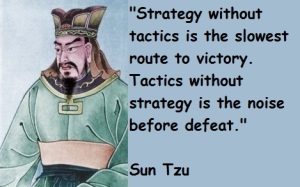Job ads are pretty lame at the best of times. Rife with cliche and weasel words, they demand ‘team players’ or ‘superstars’; they promise a ‘a fun working environment’ and ‘great benefits’.
I’ll admit, I’ve written my share of these. I’d like to think I’ve written some slightly less awful ones too.
But I’ve never written a genuinely honest one. You know, one that gets to the core of what you need to make it in consulting.
If I did, I think I’d include some of these.
You will have the resilience of a battle-ready SAS soldier. Special forces soldiers are pack-marched endless distances, deprived of food and sleep and brutally interrogated by their peers – all as part of their training. This means that if they’re ever captured by the enemy, they’ve developed a resilience to torture and pain.
Now, I am not saying PR is exactly like that. But the one piece of advice I’ve been given – over and over – is to toughen up. For every awesome client, there is one who treats you like a servant, who doesn’t appreciate your expertise, who gives you the flick for no reason or who is just a general nightmare of rudeness. Nothing you can do about these guys, I’m afraid. Just suck it up and be glad you aren’t being pack-marched to exhaustion.
You will need to be a little bit Freud, a little bit Dr Phil. Part of being a ‘trusted adviser’ is knowing where your client’s head is at. When they have an unreasonable outburst, disappear from sight for weeks or provide baffling feedback, it’s usually because they have a bunch of shit going on at their end.
When you’re agency-side, you might not see the enormous pressure senior executives are under, or how under-resourced a marketing team is; instead, you have to intuit this from the clues they give you. Try and remember they have a lot more going on than approving your media release.
You will need to love business, not just people. Do you ever hear PR grads say they chose PR because they ‘love people’ and ‘love writing’? I do, and shake my head. PR isn’t about parties and chatting to your friends – it’s about helping your client achieve a business goals. It’s not about getting media hits, it’s about driving sales. And you aren’t in an agency to look good (a revelation to some grads), but to make money and grow the business. This bare fact seems to escape people most of the time, but those who understand it are the ones who kick arse.
You will need the mind of Sun Tzu and the smile of Mother Theresa. Consulting is full of ambitious, driven people who have their own agenda. Don’t let those people shape your path; forge your own. Be clear about your goals and how to get there.
Sometimes, you’ll need to work the politics, form alliances and play the long game. That’s because a successful career requires more than just good intentions; it needs a strategy too.
In fact, the most challenging part of work is rarely the ‘the work’ itself. But paying attention to the intangibles – the ’emotional intelligence’ part of your job – if often where the real magic happens.
Like this post? Share!
And that is: to be a good reader.
Over the years, I’ve coached a lot of people on their writing. I’m sure some of them would describe it more as ‘kicking their arse about obscure points of grammar and sentence structure’ – but you get the idea.
I’m comfortable in saying I’m a good writer. I’m a long way off saying I’m a great writer.
Let me tell you about great writers. Sometimes I pick up a copy of The New Yorker (sent all the way from NYC by my good friend Gigi). Its long-form journalism is so brilliant it almost makes my eyes water. It balances painstaking research with masterful structure; it reveals and withholds details in such perfect order; it creates sympathy and raises ire in perfect measure. I want to be those writers.
Then I pick up The Monthly, which is really the closest thing Australia has to the New Yorker. Some of the nation’s best writers pen columns – often less than a thousand words – and they are brilliant. They capture a topic, a moment, a theme, with an almost magical brevity.
If you only ever read daily news journalism, you’d miss out on the impressive wrangling of language and narrative, characterised by these types of publications. Together with literary journals like Meanjin, they occupy an important place between fiction and the news of the day.
But some aspiring writers aren’t even reading the news of the day. I have lost count of the number of people who tell me they want to improve their writing, and yet fail to open the newspaper on a daily basis. They want to do a ‘writing course’.
I have a course for you: it’s called Amazon.com.
It doesn’t matter if you want to write a media release or an epic novel: you have to read other people’s work. It’s only by reading widely that you absorb the vast vocabulary available to you; that you find out the pace and rhythm of words that appeals to you; that you learn by osmosis what good writing sounds, feels and tastes like.
And in a professional sense, you need a lot of background and contextual information to write knowledgeably on a topic. People who see me lingering with the Financial Review every morning, may think it isn’t real work. But when you need to write a column on asset allocation, on behalf of a funds management expert, then you need a basic level of knowledge to translate their language – and to run it through the bullshit meter.
It is absolutely crystal clear to me when someone has tried to write on a topic they don’t understand. The concepts and logic become jumbled; the language is murky and imprecise. The writer takes their reader along on a journey of confusion and consternation.
So if you want to write well, you need to spend time reading first.
I’ve spoken before about the value of reading the classics, and I restate that here. The nineteenth century, in particular, was an important time, when a formal and flowery use of English became slightly more relaxed yet still very correct. (That’s why reading David Copperfield is way more fun than reading Tristram Shandy. In my view, anyway). So the best Victorian-era writers give us an important lesson on structure and form, while still being accessible and entertaining. You don’t need to copy them, but you can learn from them.
And then the early 20th century’s best writers brought a new and modern feel to language. Read Hemingway, and you’ll feel bad about every superfluous word and wayward adjective you have ever written.
Really, I could go on forever listing books and authors, and exhorting you to discover George Eliot et al.
But don’t overthink it. Just turn off the TV, close Facebook and pick up something decent to read.
My mum simply cannot believe we don’t get paid to pitch.
She’s seen me work on pitches – including long teleconferences while I’m on holidays at her house – and has heard how stressful they are.
‘And you can’t charge anyone for all that work?’ she says in an incredulous voice.
If you don’t work in professional services, it sounds kind of nuts. The work, the hours, the creativity that goes into winning a new client (or worse, keeping a current one).
And all the time, you have no idea what’s going on client-side.
Maybe they’re holding a beauty parade because the board told them to review suppliers. Maybe they have no intention of leaving their current supplier.
Or maybe it’s a fishing exercise to see how much it would cost, but they decide it’s waaay too expensive.
Maybe the marketing team wants to choose you, but the CEO wants to give the gig to their old friend/former agency/mate’s daughter.
Or perhaps the corporate comm manager who called the pitch is actually about to get sacked. (Yep, seen that one.)
Either way, the whole thing is a big ol’ pain in the butt, with more losers than winners. But that’s the game, and we’ve all chosen to play it.
What makes it more or less bearable is the way we’re treated throughout it. Just like you can tell a lot about someone by the way they treat waiters, you can gauge a person and an organisation by they way they deal with suppliers.
Last December, we presented to the board of a former client. They were all excited and positive. Give us a proposal! Tell us how much!
After a couple of months of hearing nothing, it was flicked down the chain to marketing. Fine, we’ll go meet with them. Oh, the brief has changed? Ok. Oh, the pitch is now competitive? Ok. Oh, you want a new proposal? Sure.
After a couple more months of hearing nothing, I finally get an email. ‘Thanks but no thanks. No guernsey for you’. Not a word of explanation, no feedback, no insights into what went wrong. Even when I asked for it.
That’s the kind of shit, right there, that sends people heading to the Ashram. It’s ok that we don’t win every pitch. But what makes it a little less painful is learning from it, getting some intelligence on our competitiveness, even just feeling like we were close.
Luckily, right after this episode, I had a meeting with the CEO of a long-term client, who is not only passionate about his industry and the super fund he works for – he is also a damn nice guy. When the person at the top is a decent human being, it shows in the way the company runs. It comes out in their brand, customer satisfaction, growth and relationships. Good stuff creates more good stuff. It’s not rocket science.
So why do so many people act like tools? What’s the big challenge with treating people respectfully, appreciating their work, valuing their time?
We are all clients and we are all suppliers at some point. So let’s think about the interactions we have and try to make sure we’re creating the good stuff, as often and as much as we can.
photo credit: cesarastudillo via photopin cc
Time in a PR agency can be measured in dog years. I’ve been in consulting for over a decade now, so that’s about 70 years in normal career time. I reckon I should be able to retire; sadly, my superannuation fund doesn’t agree.
PR consulting is an emotionally intensive game. When you’re winning (clients, media hits … whatever) it’s inspiring and satisfying. When you’re losing clients, when nobody on earth wants to run your story, when you have a client that sucks your will to live … well, there are some tough times to be had. I guess every job is like that in some ways; maybe PR just attracts emotional people.
When I had a particularly rough day recently, I threatened to disappear to an ashram. It’s become a bit of touchstone for me and my colleague David. On a good day, the Ashram Rating is low; on a bad one, we start googling the closest ones.
But all jokes aside, work can be tough. The things that keep us here, doing what we do, come down to the people we work with and the cool work we get to do. So I decided to make a list of the things that make my job awesome, and which keep the Ashram rating to ‘low’ most days.
1. Friends – I’m pretty spoiled, in that I work with a bunch of people who totally rock. Whether we are having $3 Friday drinks together (seriously, that exists in Sydney!) or they are staging an intervention when I can’t possibly write the proposal I need to write, friends are what make work … well .. less worky.
2. Mentors – It was a good day when I decided to come and work for the inimitable Tom Buchan. He’s had a profound influence on my career, starting from the time when I handed him my first new business proposal and he told me the writing was ‘shit’. He was right, it was. Tom and a bunch of other smarter, more experienced people have made a big difference to my career. Everyone needs at least one good mentor.
3. Asking for help – It’s no use having either friends or mentors, if you don’t reach out to them. People aren’t mind readers; if you want their support, you often have to be very explicit about it. They generally love giving it, but it’s up to you to show a little vulnerability.
4. New stuff – One of my clients is a career management expert, and he says that the key to staying engaged in your job is to keep ‘stretching’ – doing new, different things that challenge you. Sometimes, you need to proactively look for things that get you outside the orbit of your everyday work. Put your hand up for a taskforce, teach yourself to make an Infographic (I have, but I suck) – whatever you can do, find ways to make it new and different
5. Martinis – sometimes, alcohol is the only way to deal with the slings and arrows of outrageous fortune. Wine is fine too.
What about you? What gets you through the tough days?
“Happy families are all alike; every unhappy family is unhappy in its own way.”.
It’s one of the most famous opening lines of any novel, but I’m not convinced Tolstoy was right.
Anna Karenina’s marriage was a mystery to those outside it, but if we break it down to the simplest cliche, it runs something like ‘Distant older husband, wife feels unloved, hot young guy comes in and sweeps her off her feet. Turns to shit’.
Maybe all our lives are a cliche when reduced to a few sentences…
Anyway, that’s not the point. The point is that there are archetypal relationships, and these apply just as easily to client relationships as they do to marriages.
And just as not every marriage can be saved, not every client will stick around for the long haul. I’ve been in this game long enough to know that you can be the best partner in the world, and still lose a client.
But there are some warning signs, and sometimes if you spot them early enough, you can mount a campaign to hang on. Here are some of the marriage breakdowns I’ve been through, and what you can potentially do to avoid them. And if you can’t, at least you know you’re not alone!
- ‘It’s not you, it’s me’. This is the client who has so much shit going on internally, they can’t focus on their external positioning to give you the time of day. Usually a client in financial crisis, they either don’t have time and headspace for PR, or some bean-counter runs a big red line through the PR budget and then you’re outta there. Not much you can do to intervene here, except stay in contact and wait for things to look up. Or work on smaller, low-cost projects to keep your hand in and the relationship strong.
- ‘I’m trading you in for a younger model’. You’ve been on retainer with this client forever, and they get a new leader, or the board gets it in their head that suppliers need a shake-up. It will often go out to pitch, but you’re only there as window-dressing – like turning up to marriage counselling for the sake of it. In reality, they have a fresh new agency with a bagful of promises, ready to wow them with blue sky thinking. Again, there’s not a lot you can do here except hope the new lot screws it up and the client comes back (yep, it happens).
- ‘I want to see other people’. This is not as terminal as the situation above. They want to put the feelers out to see what else is out there, and maybe even open it up to pitch. But they aren’t really committed to going – they just want to see it there’s anything better on offer. If you can bring your A-game, come up with some genuinely new ideas, freshen up the team and bring some value-adds to the account, you could well keep it. But you know it’s going to have to be flowers and candlelight dinners all the time from now on, as the client will always have one eye on your competition.
- ‘I’m going to the shop for a pack of cigarettes’. You know the bloke who just ups and leaves one day, with no warning and no discussion. Yeah, that guy exists as a client. Sometimes it’s a directive from the board, sometimes it’s just an unpredictable CEO, sometimes there is no rhyme or reason you can see. You just get a call, get axed and then try to work out a termination clause. This is the shit that sends you running for the ashram, especially if you’ve been doing good work. But that’s consulting: win some, lose some.
- ‘You take me for granted’. Let’s admit, sometimes a client is good mate, you’ve worked with them for ages, you do pretty good work … but. You get a bit complacent, you have other, more demanding clients, you get stuck in a rut. This is the situation you have the most control over. You need to bring out some new lingerie every now and then (figuratively ok? Although literally could work in some situations). A new idea, a new campaign idea, a value-add such as training. The key is to keep it fresh and keep reinventing before they have the chance to get bored.
Ultimately, no relationship is forever – certainly not in consulting. The key is to control the things you can, and try not to take it personally when you can’t. And if all else fails, go to the pub.
photo credit: Dustin Diaz via photopin cc




